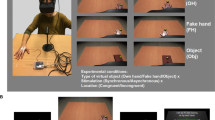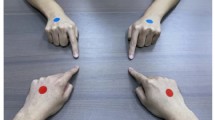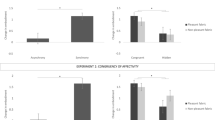Abstract
The experience of body ownership can be successfully manipulated during the rubber hand illusion using synchronous multisensory stimulation. The hypothesis that multisensory integration is both a necessary and sufficient condition for body ownership is debated. We systematically varied the appearance of the object that was stimulated in synchrony or asynchrony with the participant’s hand. A viewed object that was transformed in three stages from a plain wooden block to a wooden hand was compared to a realistic rubber hand. Introspective and behavioural results show that participants experience a sense of ownership only for the realistic prosthetic hand, suggesting that not all objects can be experienced as part of one’s body. Instead, the viewed object must fit with a reference model of the body that contains important structural information about body parts. This body model can distinguish between corporeal and non-corporeal objects, and it therefore plays a critical role in maintaining a coherent sense of one’s body.



Similar content being viewed by others
References
Armel KC, Ramachandran VS (2003) Projecting sensations to external objects: evidence from skin conductance response. Proc R Soc Lond B Biol Sci 270:1499–1506
Austen EL, Soto-Faraco S, Enns JT, Kingstone A (2004) Mislocalisation of touch to a fake hand. Cogn Affect Behav Neurosci 4:170–181
Botvinick M, Cohen J (1998) Rubber hands ‘feel’ touch that eyes see. Nature 391:756
Capelari ED, Uribe C, Brasil-Neto JP (2009) Feeling pain in the rubber hand: integration of visual, proprioceptive, and painful stimuli. Perception 38:92–99
Costantini M, Haggard P (2007) The rubber hand illusion: sensitivity and reference frame for body ownership. Conscious Cogn 16:229–240
Daprati E, Sirigu A, Pradat-Diehl P, Franck N, Jeannerod M (2000) Recognition of self-produced movement in a case of severe neglect. Neurocase 6:477–486
De Preester H, Tsakiris M (2009) Body-extension versus body-incorporation: is there a need for a body-model? Phenomenol Cogn Sci 8(3):307–319. doi:10.1007/s11097-009-9121-y
De Vignemont F, Tsakiris M, Haggard P (2005) Body mereology. In: Knoblich G, Thornton I, Grosjean M, Shiffrar M (eds) Human body perception from the inside out. Oxford University Press, Oxford
Durgin FH, Evans L, Dunphy N, Klostermann S, Simmons K (2007) Rubber hands feel the touch of light. Psychol Sci 18:152–157
Ehrsson HH (2007) The experimental induction of out-of-body experiences. Science 317:1048
Ehrsson HH, Spence C, Passingham RE (2004) That’s my hand! Activity in premotor cortex reflects feeling of ownership of a limb. Science 305:875–877
Ehrsson HH, Holmes NP, Passingham RE (2005) Touching a rubber hand: feeling of body ownership is associated with activity in multisensory brain areas. J Neurosci 25:10564–10573
Ehrsson HH, Wiech K, Weiskopf N, Dolan RJ, Passingham RE (2007) Threatening a rubber hand that you feel is yours elicits a cortical anxiety response. Proc Natl Acad Sci 104:9828–9833
Ehrsson HH (2009) How many arms make a pair? Perceptual illusion of having an additional limb. Perception 38:310–312
Graziano MSA, Botvinik MM (2001) How the brain represents the body: insights from neurophysiology and psychology. In: Prinz W, Hommel B (eds) Common mechanisms in perception and action, attention and performance XIX. Oxford University Press, Oxford
Graziano MS, Cooke DF, Taylor CS (2000) Coding the location of the arm by sight. Science 290:1782–1786
Haans A, Ijsselsteijn WA, de Kort YA (2008) The effect of similarities in skin texture and hand shape on perceived ownership of a fake limb. Body Image 5(4):389–394
Hägni K, Eng K, Hepp-Reymond MC, Holper L, Keisker B, Siekierka E, Kiper DC (2008) Observing virtual arms that you imagine are yours increases the galvanic skin response to an unexpected threat. PLoS One 3(8):e3082
Holmes NP, Spence C (2006) Beyond the body schema: visual, prosthetic, and technological contributions to bodily perception and awareness. In: Knoblich G, Thornton I, Grosjean M, Shiffrar M (eds) Human body perception from the inside out. Oxford University Press, Oxford, pp 15–64
Holmes NP, Snijders HJ, Spence C (2006) Reaching with alien limbs: visual exposure to prosthetic hands in a mirror biases proprioception without accompanying illusions of ownership. Percept Psychophys 68:685–701
Howell DC (1997) Statistical methods for psychology, 4th edn. Duxbury, Belmont
Kammers MP, Verhagen L, Dijkerman HC, Hogendoorn H, De Vignemont F, Schutter DJ (2008) Is this hand for real? Attenuation of the rubber hand illusion by transcranial magnetic stimulation over the inferior parietal lobule. J Cogn Neurosci 21:1311–1320
Kammers MP, de Vignemont F, Verhagen L, Dijkerman HC (2009) The rubber hand illusion in action. Neuropsychologia 47:204–211
Lenggenhager B, Tadi T, Metzinger T, Blanke O (2007) Video ergo sum: manipulating bodily self-consciousness. Science 317:1096–1099
Lloyd DM (2007) Spatial limits on referred touch to an alien limb may reflect boundaries of visuo-tactile peripersonal space surrounding the hand. Brain Cogn 64:104–109
Longo M, Schüür F, Kammers MPM, Tsakiris M, Haggard P (2008) What is embodiment? A psychometric approach. Cognition 107:978–998
Longo MR, Schüür F, Kammers MP, Tsakiris M, Haggard P (2009) Self awareness and the body image. Acta Psychol 132(2):166–172
Makin TR, Holmes NP, Ehrsson HH (2008) On the other hand: dummy hands and peripersonal space. Behav Brain Res 191:1–10
Moseley GL, Olthof N, Venema A, Don S, Wijers M, Gallace A, Spence C (2008) Psychologically induced cooling of a specific body part caused by the illusory ownership of an artificial counterpart. Proc Natl Acad Sci 105:13169–13173
Pavani F, Spence C, Driver J (2000) Visual capture of touch: out-of-the-body experiences with rubber gloves. Psychol Sci 11:353–359
Pavani F, Zampini M (2007) The role of hand size in the fake-hand illusion paradigm. Perception 36:1547–1554
Petkova VI, Ehrsson HH (2008) If I were you: perceptual illusion of body swapping. PLoS One 3(12):e3832
Press C, Heyes C, Haggard P, Eimer M (2008) Visuotactile learning and body representation: an ERP study with rubber hands and rubber objects. J Cogn Neurosci 20:312–323
Schütz-Bosbach S, Mancini B, Aglioti SM, Haggard P (2006) Self and other in the human motor system. Curr Biol 16(8):1830–1834
Schütz-Bosbach S, Tausche P, Weiss C (2009) Roughness perception during the rubber hand illusion. Brain Cogn 70:136–144
Schwoebel J, Coslett HB (2005) Evidence for multiple, distinct representations of the human body. J Cogn Neurosci 17:543–553
Sirigu A, Grafman J, Bressler K, Sunderland T (1991) Multiple representations contribute to body knowledge processing. Evidence from a case of autotopagnosia. Brain 114:629–642
Slater M, Perez-Marcos D, Ehrsson HH, Sanchez-Vives MV (2008) Towards a digital body: the virtual arm illusion. Front Hum Neurosci 2:6
Tsakiris M (2008) Looking for myself: current multisensory input alters self-face recognition. PLoS One 3(12):e4040
Tsakiris M (2009) My body in the brain: a neurocognitive model of body-ownership. Neuropsychologia (in press)
Tsakiris M, Haggard P (2005) The rubber hand illusion revisited: visuotactile integration and self-attribution. J Exp Psychol Hum Percept Perform 31:80–91
Tsakiris M, Prabhu G, Haggard P (2006) Having a body versus moving your body: how agency structures body-ownership. Conscious Cogn 15:423–432
Tsakiris M, Hesse M, Boy C, Haggard P, Fink GR (2007a) Neural correlates of body-ownership: a sensory network for bodily self-consciousness. Cereb Cortex 17:2235–2244
Tsakiris M, Schütz-Bosbach S, Gallagher S (2007b) On agency and body-ownership: phenomenological and neurocognitive reflections. Conscious Cogn 16:645–660
Tsakiris M, Costantini M, Haggard P (2008) The role of the right temporoparietal junction in maintaining a coherent sense of one’s body. Neuropsychologia 46:3014–3018
Vallar G, Ronchi R (2009) Somatoparaphrenia: a body delusion. A review of the neuropsychological literature. Exp Brain Res 192:533–551
Acknowledgments
Dr. Tsakiris and Dr. Fotopoulou were supported by the European Platform for Life Sciences, Mind Sciences, and the Humanities” grant by the Volkswagen Stiftung for the “Body-Project: interdisciplinary investigations on bodily experiences”. The authors would like to thank Philip Roberts for developing the stimuli.
Author information
Authors and Affiliations
Corresponding author
Appendix
Appendix
-
Ownership statements
-
…it seemed like I was looking directly at my own left hand, rather than at an object.
-
…it seemed like the object began to resemble my real hand.
-
…it seemed like the object belonged to me.
-
…it seemed like the object was my left hand
-
…it seemed like the object was part of my body.
-
-
Location statements
-
…it seemed like I was feeling the touch of the paintbrush in the location where I saw the object touched.
-
…it seemed like my left hand was in the location where the object was.
-
…it seemed like the object was in the location where my left hand was.
-
…it seemed like the touch I felt was caused by the paintbrush touching the object.
-
-
Loss of one’s hand statements
-
…it seemed like I was unable to move my left hand.
-
…it seemed like I couldn’t really tell where my left hand was.
-
…it seemed like my left hand had disappeared.
-
…it seemed like my left hand was out of my control.
-
-
Agency statements
-
…it seemed like I could have moved my left hand if I had wanted.
-
…it seemed like I could have moved the object if I had wanted.
-
…it seemed like I was in control of the object.
-
Rights and permissions
About this article
Cite this article
Tsakiris, M., Carpenter, L., James, D. et al. Hands only illusion: multisensory integration elicits sense of ownership for body parts but not for non-corporeal objects. Exp Brain Res 204, 343–352 (2010). https://doi.org/10.1007/s00221-009-2039-3
Received:
Accepted:
Published:
Issue Date:
DOI: https://doi.org/10.1007/s00221-009-2039-3




